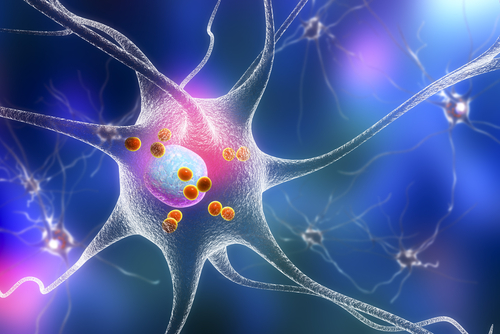Brain Cell Research on Misfolded Proteins May Lead to New Therapies

Scientists have discovered how misfolded proteins in brain cells — those carrying mutations associated with Parkinson’s disease — spread to nearby healthy cells, a study reported.
These findings support the development of therapies that may prevent Parkinson’s progression, the researchers noted.
The study, “α-Synuclein mutation impairs processing of endomembrane compartments and promotes exocytosis and seeding of α-synuclein pathology,” was published in the journal Cell Reports.
Parkinson’s disease is thought to be triggered by the misfolding of a protein known as alpha-synuclein. This is supported by the observation that mutations in the SNCA gene, which encodes alpha-synuclein, cause familial disease.
Misfolded alpha-synuclein forms aggregates, or clumps, and accumulates in nerve cells (neurons) in the brain that generate dopamine, a signaling molecule that plays a role in motor function. Eventually, aggregated alpha-synuclein spreads to other brain cells in regions involved in cognition, sleep, and mood.
Current therapies aim to ease symptoms by replacing the missing dopamine. Still, long-term treatment can lead to involuntary movements known as dyskinesia, and to fluctuations in motor symptoms that impact quality of life. As such, there is a need to find therapies to stop the disease from spreading, thus halting progression.
“Most current therapies centre around increasing the release of dopamine, but that works for a brief period and has a lot of side effects,” Scott Ryan, PhD, a professor in the department of molecular and cellular biology at the University of Guelph, in Canada, said in a press release.
“Reduced quality of life can be a huge burden on patients, their families and the health-care system,” added Ryan, who led the study.
Alpha-synuclein aggregation, accumulation, and subsequent toxicity have been associated with impaired autophagy — the cellular process by which cells degrade and release unnecessary or damaged components.
“Regular protein turnover [recycling] is part of a healthy cell,” said Morgan Stykel, a PhD candidate at the university and the study’s lead author.
“With Parkinson’s disease, that system is not working properly,” Stykel noted.
However, the underlying mechanisms of this impairment remain unclear.
To learn more, the researchers used stem cells to create neurons with and without Parkinson’s to examine the effects of alpha-synuclein mutations.
Two stem cell lines were created, each with a mutation associated with Parkinson’s (A53T and E46K), to understand how dopamine-producing neurons clear alpha-synuclein clumps.
The first set of experiments found that, compared with control cells, alpha-synuclein was aberrantly modified by phosphate molecules — called phosphorylation — in both mutant cell lines. Those findings were “consistent with the form of [alpha-synuclein] associated with pathological [disease-causing] aggregates in human synucleinopathy brain,” the researchers wrote.
Additionally, the impact of this altered phosphorylation in mutant cells led to the accumulation of cell structures called multivesicular bodies (MVBs) over controls, which strongly suggested “an attempt by these neurons to increase transport of [alpha-synuclein aggregates],” they added. Of note, MVBs are a type of cellular vesicle that carry content that can be degraded or released into the extracellular space.
In the nervous system, the autophagy protein LC3B normally targets misfolded proteins to be degraded. Experiments showed LC3B and abnormally phosphorylated alpha-synuclein were elevated in the mutant cells as compared with the controls and were localized together.
Notably, in mutant cells, LC3B and alpha-synuclein were found to directly interact with each other and to together form aggregates leading to the inactivation of LC3B.
Most alpha-synuclein associated with LC3B was seen on the surface of MVBs. That led to the alpha-synuclein’s release from cells by exosomes — tiny sacs within cells that carry components to be secreted.
Moreover, the increased secretion of aggregated alpha-synuclein by exosomes spread to other neighboring healthy neurons. There, it promoted further clumps of alpha-synuclein instead of being degraded by cell compartments called lysosomes that contain digestive enzymes.
Finally, the overproduction of the mature form of LC3B in mutant cells reduced the levels of secreted alpha-synuclein to those seen in normal cells, which demonstrated that “restoring LC3B function in SNCA mutant neurons promotes clearance of intracellular [aggregates] and reduces the level of [alpha-synuclein] secreted via exosomes,” the researchers wrote.
“Normally, misfolded proteins are degraded,” Ryan said. “We found a pathway by which synuclein is being secreted and released from neurons instead of being degraded.”
“We hope to turn the degradation pathway back on and stop the spread of disease,” Ryan said
The investigators noted their findings could help develop new therapies.
“We may not be able to do anything about brain regions that are already diseased, but maybe we can stop it from progressing,” said Ryan. “We might be able to turn the degradation pathway back on and stop the spread of the disease.”






